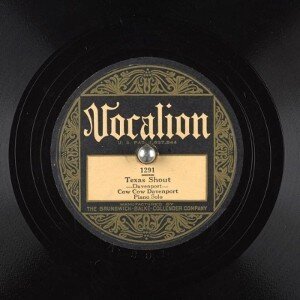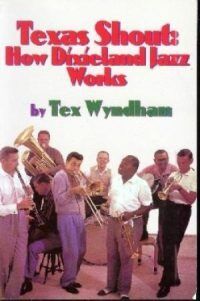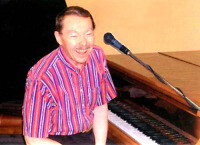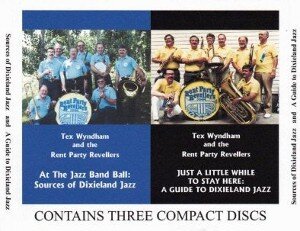 Set forth below is the forty-fourth “Texas Shout” column. The initial installment of a two-part essay, it first appeared in the October 1993 issue of the West Coast Rag, now known as The Syncopated Times.
Set forth below is the forty-fourth “Texas Shout” column. The initial installment of a two-part essay, it first appeared in the October 1993 issue of the West Coast Rag, now known as The Syncopated Times.
In last month’s “Texas Shout,” I discussed the Dixieland style known as “downtown New Orleans”. Today I’d like to talk about the other vintage- period Dixieland style played by Crescent City Black musicians, which is called, not surprisingly, “uptown New Orleans.”
To give you all a quick idea of the type of jazz I’m referring to, The Preservation Hall Jazz Band, probably the most famous Dixieland band in the world, plays uptown New Orleans. I’d guess that most readers of this publication have heard that combo or its records and are reasonably familiar with its sound.
Uptown New Orleans is the closest of the seven Dixieland styles to a folk music. Its players express themselves on their instruments in highly personal ways which often pay little or no attention to the accepted “legitimate” performance modes.
Thus, to a listener conditioned to hearing schooled musicians, some uptown players may sound thin-toned or sour-toned. Tuning up within the band may not be as precise as in more schooled styles. Uptown routines may appear to have ragged edges (trumpeter Kid Thomas Valentine would sometimes start a tune by beginning to play it, letting each other sideman enter as soon as he recognized the selection).
No premium is placed in uptown New Orleans on instrumental virtuosity or dazzling solos. There are almost no screech-range trumpeters, lip-trilling trombonists, etc., in this branch of Dixieland. In many cases, soloists stick closely to the melody, adding a few phrase-end fills or decorations to personalize the chorus.
Some jazz critics are unable to make their peace with these characteristics of the music. They tend to denounce uptowners as unskilled performers who can’t play their instruments.
In my view, such critics are listening to the wrong thing and are missing some highly satisfying jazz in the process. Although one often gives up technical agility, fleet runs, high notes, resonant tones, crisp section work, etc., in uptown New Orleans, one receives in exchange a very high level of communication on an emotional level with the artists. Uptown style at its best delivers a sense of righteousness, of conviction, that is most exhilarating to experience.
Uptown New Orleans has the highest blues content of the seven Dixieland styles. Said another way, it makes extensive use of bent tones, “blue” notes or other off-pitch sounds which, when properly deployed, create a unique vision of the material, transforming even a frequently-played standard into something fresh and provocative.
This branch of Dixieland emphasizes ensemble playing. On many of the classic recordings in the idiom, the band is heard in ensemble throughout. In other instances, while a “soloist” may temporarily come to the fore of the sound, quite often the other musicians will continue to play throughout the solo, though at a subdued volume.
The style comes out of a dance hall tradition and is strongly audience-oriented. Uptown musicians often engage as a matter of course in activities that some musicians in other styles consider demeaning, such as marching through the crowd, dancing around the stage or presenting good-natured hokum/comedy numbers.
Putting a premium on entertaining the paying customers without compromising the integrity of their music, many veteran uptowners see no reason to avoid such crowd-pleasing antics that will heighten the hilarity of the show. Again Kid Thomas comes to mind, with his “Milk Cow Blues” routine in which he does both the male and female vocal, as well as clarinetist Willie Humphrey’s bumps and grinds while soloing on “Li’l Liza Jane.”
Further, in keeping with their audience orientation of playing what the audience wants to hear, the uptown bands are willing to play requests, even ones for familiar evergreens that revivalist Dixielanders claim are overplayed. Indeed, The Preservation Hall Jazz Band regularly closes its shows with “When The Saints Go Marching In.”
For me, many of these characteristics, though regarded in some circles as deficiencies, operate to make uptown New Orleans a very accessible, easy-to-enjoy music. Uptown New Orleans makes a point of inviting the listener into the action.
When it’s hitting on all cylinders, its emotional power and zestful drive are irresistible. Personally, I’ll never forget the last time I saw the Billie and De De Pierce unit of The Preservation Hall Jazz Band, digging in and whipping the audience in a University Of Delaware concert hall into an absolute frenzy.
For reasons related in last month’s column, very little uptown New Orleans was recorded during the twenties. The style first attracted widespread notice during the Dixieland revival of the early forties, specifically with the initial recordings by one of its most important figures, trumpeter William Geary “Bunk” Johnson.
That session took place on June 11, 1942 in a third-floor piano storeroom of Grunewald’s Music Store in New Orleans. Included in the septet along with Johnson were three other musicians who were to become the archetypes of uptown New Orleans on their instruments: clarinetist George Lewis, trombonist Jim Robinson and banjoist Lawrence Marrero.
Johnson was not an active musician at the time of that recording and essentially used Lewis’ band for that purpose. It went on to achieve national fame.
Following Johnson’s death in 1949, the septet, under Lewis’ leadership, became the flagship band for uptown New Orleans during the 1950s and one of the most influential Dixieland bands in jazz history. All over the world today, there are combos playing the Lewis repertoire, with each sideman trying his best to replicate the licks of his counterpart in Lewis’ most celebrated lineup: trumpeter Avery “Kid” Howard; Lewis; Robinson; pianist Alton Purnell; Marrero; bassist Alcide “Slow Drag” Pavageau; and drummer/vocalist Joe Watkins.
The Johnson and Lewis combos pretty much had the field to themselves well into the fifties. However, with the inauguration and subsequent success of Preservation Hall, other fine uptown musicians and bands started appearing more frequently on records, such as trumpeter De De Pierce and his wife, pianist/vocalist Billie Pierce; clarinetist Albert Burbank; banjoists “Creole George” Guesnon and Emanuel Sayles; alto saxophonist “Cap’n” John Handy; drummer Josiah “Cie” Frazier; and trumpeter Percy Humphrey and his brother, clarinetist Willie Humphrey.
Primus inter pares among these was probably Kid Thomas’ Algiers Stompers, a raw-edged, fiery team that was the most important uptown combo during the sixties. Its personnel, including trumpeter Kid Thomas Valentine, tenor saxophonist Emanuel Paul, trombonist Louis Nelson, bassist Joseph Butler and drummer Sammy Penn, became icons of the idiom, while the band itself spawned a number of imitators.
In many cases, devotees of this style who followed in their idols’ footsteps tended to copy the routines on the records. Such imitation sometimes went so far as replication not only of obvious clams made by the individual players on the original 78s but also of devices which (as discussed below) may not always have been the best ones.
By contrast, the uptowners strongly influenced a number of British jazzmen, specifically trumpeter Ken Colyer and trombonist Chris Barber, who began performing in the 1950s an uptown-derived style, but modified somewhat to suit their artistic leanings. Their approach in turn developed its own followers and became a Dixieland style known as “British trad.” British trad is the most recent Dixieland style to emerge, and deserves a separate column all its own.
The uptown scene was dominated for so long by the Johnson and Lewis combos that, in some circles, their way of performing seems to have been viewed as the only “correct” or “legitimate” mode in this genre. For the consideration of combos whose tastes lean toward uptown New Orleans, I’d like to mention a couple of devices which, in my view, did not always work to the benefit of the ride.
Lewis’ vocalists tended to sing two-chorus vocals in which the same lyrics were sung successively twice without interruption. To me, singing the same chorus twice in a row amounts to playing the same solo twice in a row, something you never hear because it prevents the performance from building and developing.
If you are going to have a two-consecutive-chorus vocal, then the vocalist should sing a second chorus that has different lyrics. If the vocalist is going to sing the same chorus twice, I think it better for the two vocal choruses to be separated by some kind of instrumental passage.
In order to keep fast tunes from ending too abruptly, so that the ride doesn’t seem to run into a brick wall at top speed, most bands adopt some kind of closing device that puts an exclamation point at the finale. These include “double endings” (playing two extra bars of ensemble on the tonic chord), “turnarounds” (moving to a “six (VI7)” chord on the last measure and playing the last four bars again), scored tags and a host of other effects. One of the most common has the drummer playing a four-bar tag at the end of the last chorus, after which the ensemble returns for a final four or eight bars.
The Lewis band, from time to time, would end a tune with a four-bar drum break and then play an entire full ensemble chorus as a windup. Most of the time I find the playing of a full chorus after the break to be anticlimactic.
A properly functioning combo should have developed the ride to its maximum intensity on the last chorus. It is extremely difficult to maintain or increase that kind of emotional pitch for yet one more chorus, especially after the relaxation afforded by a short break.
Both of these devices, the two-chorus repeated vocal and the full-chorus ensemble after the drum break, were picked up by uptown revivalists in the sixties. However, they were not adopted by the British trad bands and they have pretty much faded from the current scene.
Nevertheless, it is worth raising the points here. The uptowners created some immortal jazz and rightly inspired many followers. However, if the music is to remain vital, it can’t be perpetuated by mere imitation.
Those who perform it today need to maintain creativity and independent judgment regarding the music. They should continually ask themselves whether this or that element of the performance should be kept in the act. These two devices, in my view at least, are ones that revivalist uptowners should think through very carefully before deciding to emulate.

The full run of “Texas Shout” has been collected into a lavishly illustrated trade paperback entitled Texas Shout: How Dixieland Jazz Works. This book is available @ $20.00 plus $2.95 shipping from Tex Wyndham, On request, Tex will autograph the book and add a personalized note (be sure to tell him to whom the note should be addressed).
Tex Wyndham’s 3 CD Guide to Dixieland with music and commentary is available for $20 plus $2.95 shipping. The separate CD, A History of Ragtime: Tex Wyndham Live At Santa Rosa, is available for $13.00 plus $2.00 shipping. On request, Tex will autograph the inner sleeve and add a personalized note (be sure to tell him to whom the note should be addressed).
Send payment to Tex Wyndham, P.O. Box 831, Mendenhall, PA 19357, Phone (610) 388-6330.
Note: All links, pictures, videos or graphics accompanying the Shouts were added at the discretion of the Syncopated Times editorial staff. They did not accompany the original columns and do not necessarily reflect the opinion of Tex Wyndham.
From roughly 1970-2010, Tex Wyndham was: (1) one of the best-known revivalist Dixieland jazz musicians in the US, as cornetist, pianist and bandleader, (2) one of the best-known ragtime pianists in the US, and (3) one of the most respected critics in the US of Dixieland jazz, ragtime, and related music. He is the only person about whom all three of those statements can be made.




